Salby M.L. Fundamentals of Atmospheric Physics
Подождите немного. Документ загружается.

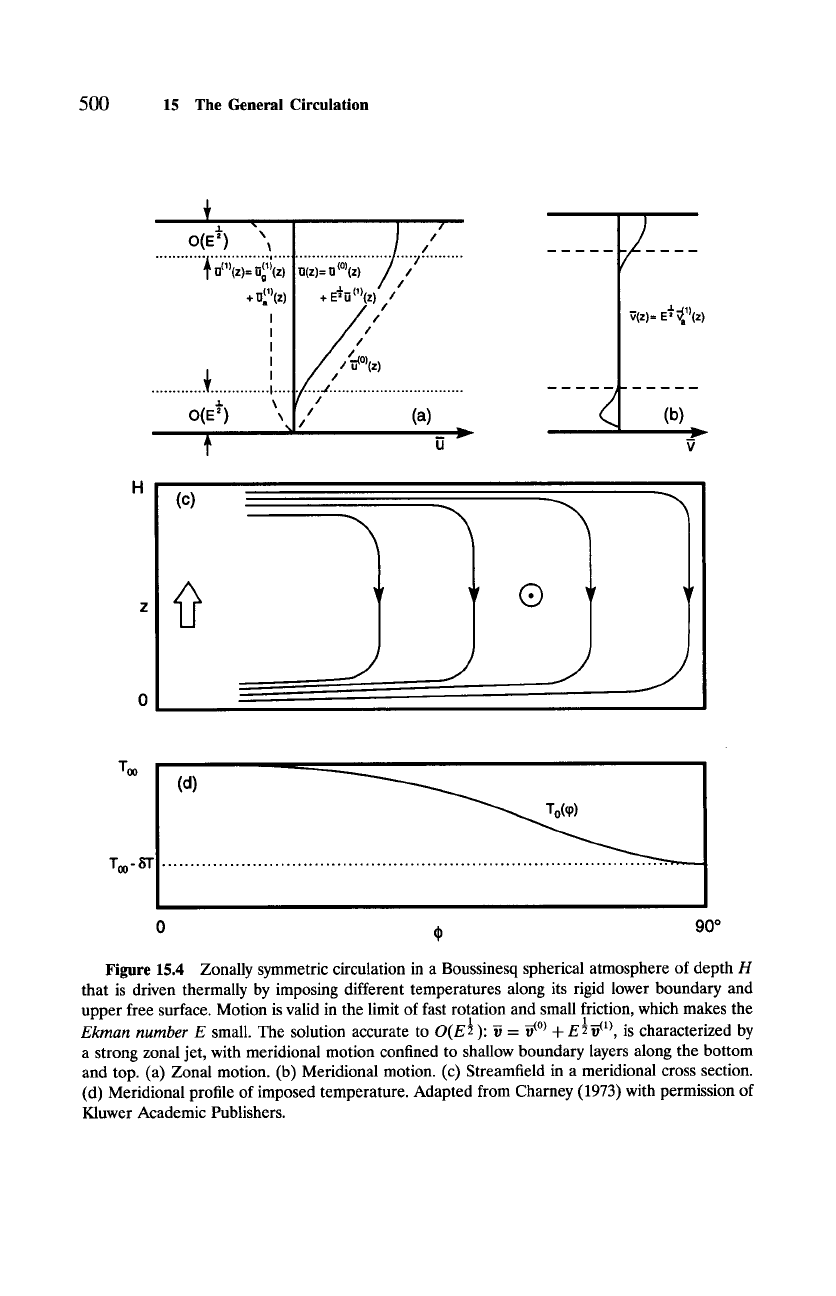
500 15 The General
Circulation
O(E ='l " ) "\
...........
I; ,~;iz;--~;;cz;
+ O~)(z)
I
I
I
I
............ .~. ............. ', ....
O(E =a') ~\
f
O(z)= g (~ / ~'
j. / /
+ E 2 U ~ /
~// / J. 1
/ )
:; iiI?I ....................
/ (a)
CI (b)
/ _ ~ ..
u
v
.. __j
Too
Too- 81"
(d) To(~~
.......................
0 r 90 ~
Figure 15.4 Zonally symmetric circulation in a Boussinesq spherical atmosphere of depth H
that is driven thermally by imposing different temperatures along its rigid lower boundary and
upper free surface. Motion is valid in the limit of fast rotation and small friction, which makes the
Ekman number E
small. The solution accurate to
O(E89
): ~ = v -(~ + E89 -(1), is characterized by
a strong zonal jet, with meridional motion confined to shallow boundary layers along the bottom
and top. (a) Zonal motion. (b) Meridional motion. (c) Streamfield in a meridional cross section.
(d) Meridional profile of imposed temperature. Adapted from Charney (1973) with permission of
Kluwer Academic Publishers.
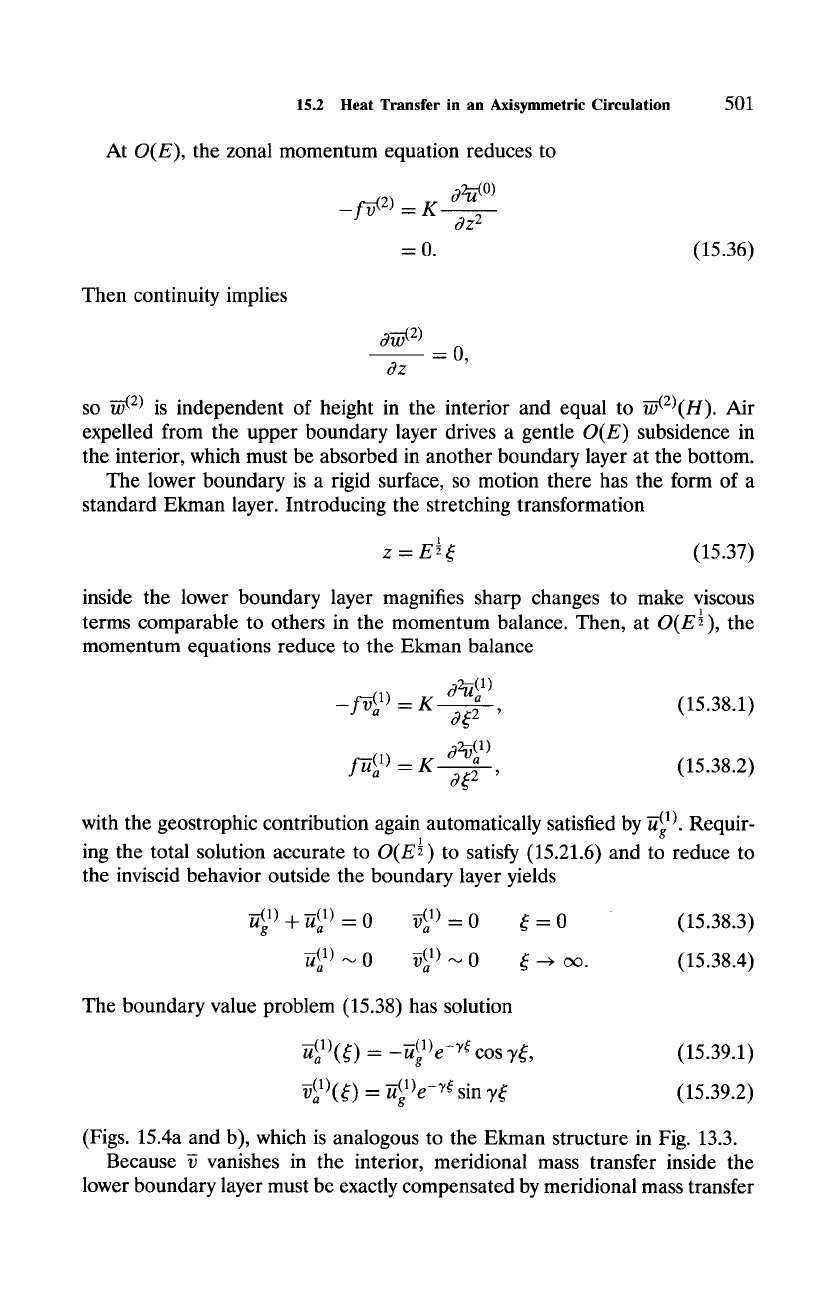
15.2 Heat Transfer in an Axisymmetric Circulation
501
At O(E), the zonal momentum equation reduces to
--f"v -(2) -- K~
a~/(o)
o~Z 2
= 0. (15.36)
Then continuity implies
o~(2)
--" 0~
o~z
so ~(2) is independent of height in the interior and equal
to
m(2)(H). Air
expelled from the upper boundary layer drives a gentle
O(E)
subsidence in
the interior, which must be absorbed in another boundary layer at the bottom.
The lower boundary is a rigid surface, so motion there has the form of a
standard Ekman layer. Introducing the stretching transformation
1
z = E~ ~: (15.37)
inside the lower boundary layer magnifies sharp changes to make viscous
terms comparable to others in the momentum balance. Then, at
O(E89
the
momentum equations reduce to the Ekman balance
-f-O~ 1) = K ~
a~:2 , (15.38.1)
f-U(a 1) --
K ~
Osc2 (15.38.2)
with the geostrophic contribution again automatically satisfied by ~1). Requir-
ing the total solution accurate to
O(E89
to satisfy (15.21.6) and to reduce to
the inviscid behavior outside the boundary layer yields
-'l" U(a 1) -- 0 V(a 1)
= 0 ~: - 0 (15.38.3)
~1) ,~, 0
V(a 1) 0 (15.38.4)
The boundary value problem (15.38) has solution
~1)(~:) _ _~(gl)e-r~ cos y~:,
~(al)(~ :) = ~(~l)e-r~: sin y~:
(15.39.1)
(15.39.2)
(Figs. 15.4a and b), which is analogous to the Ekman structure in Fig. 13.3.
Because ~ vanishes in the interior, meridional mass transfer inside the
lower boundary layer must be exactly compensated by meridional mass transfer
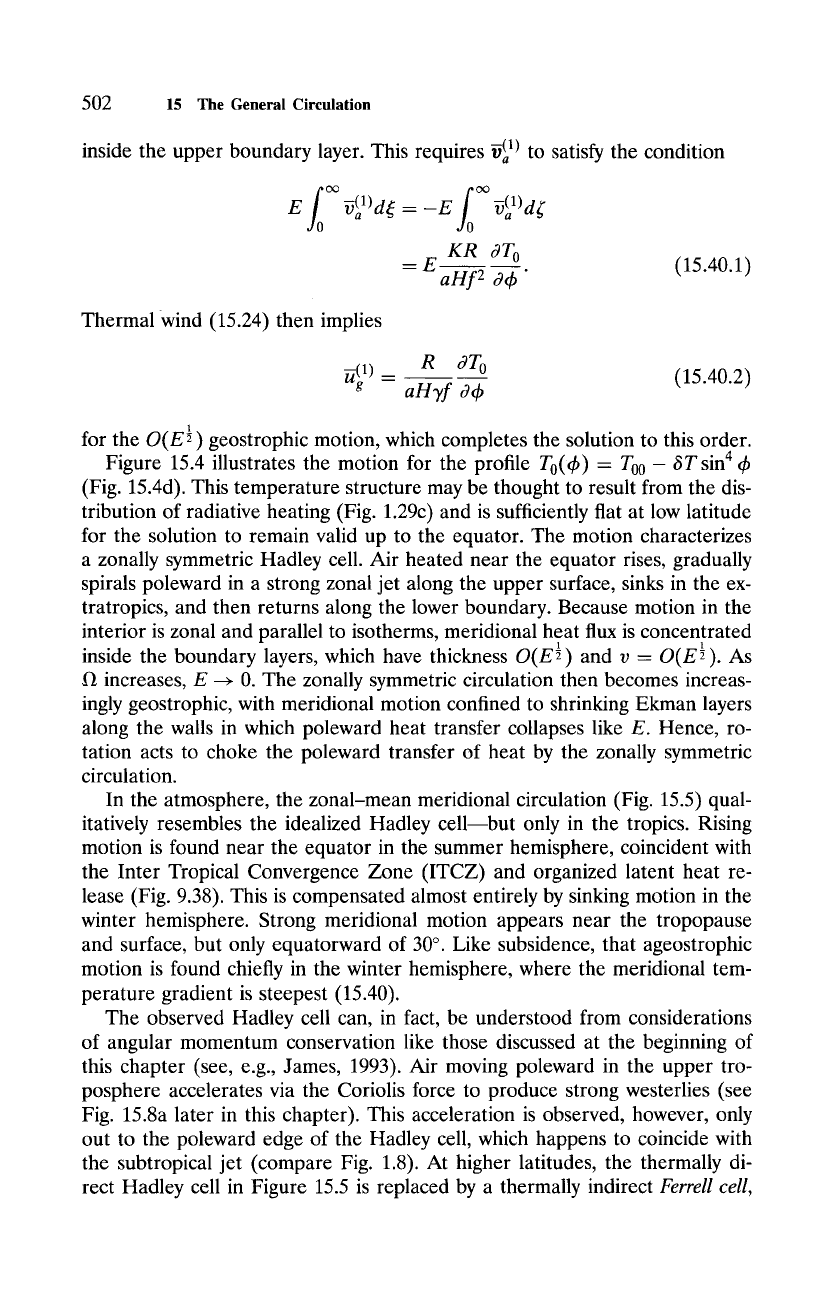
502 15
The General Circulation
inside the upper boundary layer. This requires ~Cal) to satisfy the condition
fo fo
E 9(al)ds r - -E 9(al)ds r
KR 3T o
= EaHf---5 d--~"
(15.40.1)
Thermal Wind (15.24) then implies
K(ga)
= R dT o
(15.40.2)
aHyf a~
for the
O(E89 )
geostrophic motion, which completes the solution to this order.
Figure 15.4 illustrates the motion for the profile T0(~b ) = Too- 6T sin4 ~b
(Fig. 15.4d). This temperature structure may be thought to result from the dis-
tribution of radiative heating (Fig. 1.29c) and is sufficiently flat at low latitude
for the solution to remain valid up to the equator. The motion characterizes
a zonally symmetric Hadley cell. Air heated near the equator rises, gradually
spirals poleward in a strong zonal jet along the upper surface, sinks in the ex-
tratropics, and then returns along the lower boundary. Because motion in the
interior is zonal and parallel to isotherms, meridional heat flux is concentrated
inside the boundary layers, which have thickness
O(E 1)
and v =
O(E89
As
f~ increases, E --+ 0. The zonally symmetric circulation then becomes increas-
ingly geostrophic, with meridional motion confined to shrinking Ekman layers
along the walls in which poleward heat transfer collapses like E. Hence, ro-
tation acts to choke the poleward transfer of heat by the zonally symmetric
circulation.
In the atmosphere, the zonal-mean meridional circulation (Fig. 15.5) qual-
itatively resembles the idealized Hadley cellmbut only in the tropics. Rising
motion is found near the equator in the summer hemisphere, coincident with
the Inter Tropical Convergence Zone (ITCZ) and organized latent heat re-
lease (Fig. 9.38). This is compensated almost entirely by sinking motion in the
winter hemisphere. Strong meridional motion appears near the tropopause
and surface, but only equatorward of 30 ~ Like subsidence, that ageostrophic
motion is found chiefly in the winter hemisphere, where the meridional tem-
perature gradient is steepest (15.40).
The observed Hadley cell can, in fact, be understood from considerations
of angular momentum conservation like those discussed at the beginning of
this chapter (see, e.g., James, 1993). Air moving poleward in the upper tro-
posphere accelerates via the Coriolis force to produce strong westerlies (see
Fig. 15.8a later in this chapter). This acceleration is observed, however, only
out to the poleward edge of the Hadley cell, which happens to coincide with
the subtropical jet (compare Fig. 1.8). At higher latitudes, the thermally di-
rect Hadley cell in Figure 15.5 is replaced by a thermally indirect
Ferrell cell,
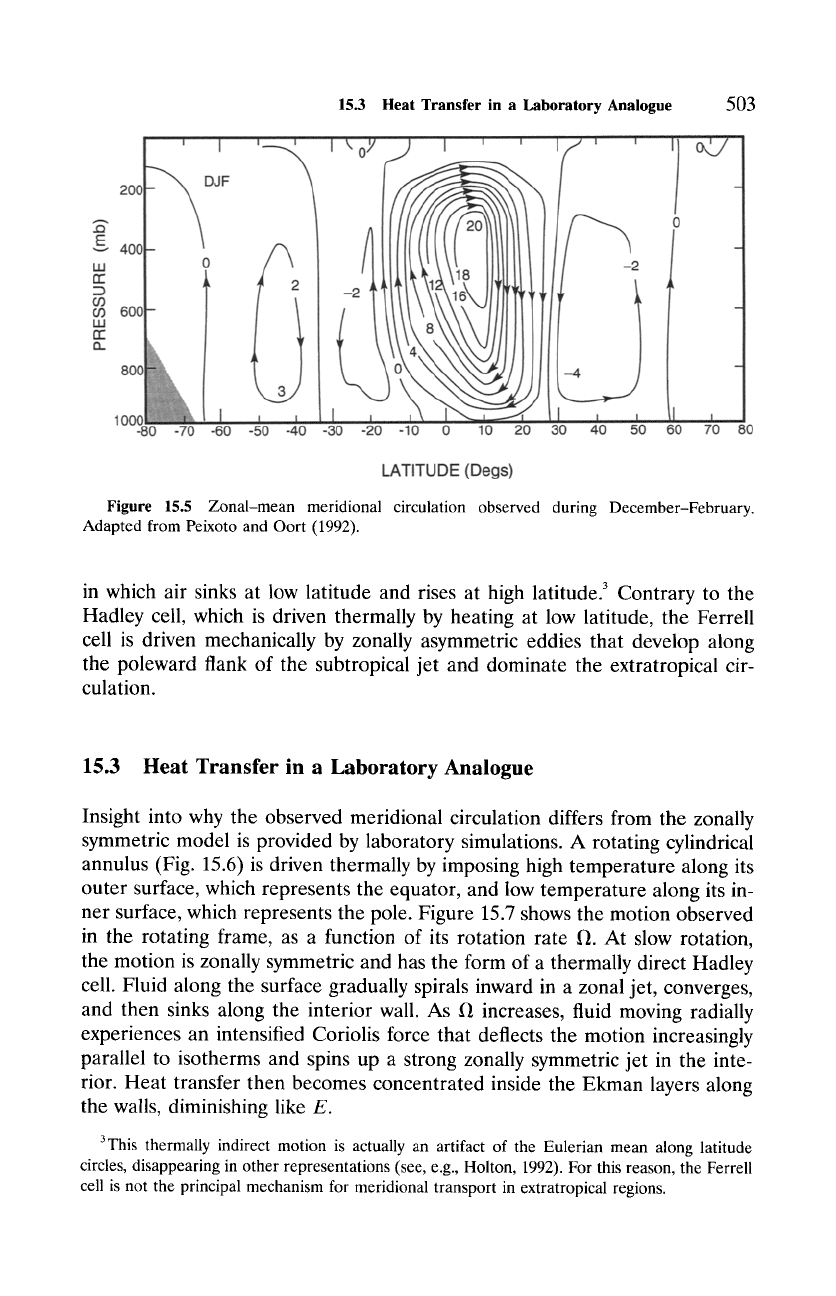
15.3 Heat
Transfer in a Laboratory
Analogue
503
200 -
o
E 400-
UJ 0 -2
n-
2 -2
O3
n-U J00
600L.
800
I
looo ~
-80-70-60-50-40-30-20-10 0 10 20 30 40 50 60 70 80
LATITUDE (Degs)
Figure
15.5 Zonal-mean meridional circulation observed during December-February.
Adapted from Peixoto and Oort (1992).
in which air sinks at low latitude and rises at high latitude. 3 Contrary to the
Hadley cell, which is driven thermally by heating at low latitude, the Ferrell
cell is driven mechanically by zonally asymmetric eddies that develop along
the poleward flank of the subtropical jet and dominate the extratropical cir-
culation.
15.3 Heat Transfer in a Laboratory Analogue
Insight into why the observed meridional circulation differs from the zonally
symmetric model is provided by laboratory simulations. A rotating cylindrical
annulus (Fig. 15.6) is driven thermally by imposing high temperature along its
outer surface, which represents the equator, and low temperature along its in-
ner surface, which represents the pole. Figure 15.7 shows the motion observed
in the rotating frame, as a function of its rotation rate 1~. At slow rotation,
the motion is zonally symmetric and has the form of a thermally direct Hadley
cell. Fluid along the surface gradually spirals inward in a zonal jet, converges,
and then sinks along the interior wall. As ~ increases, fluid moving radially
experiences an intensified Coriolis force that deflects the motion increasingly
parallel to isotherms and spins up a strong zonally symmetric jet in the inte-
rior. Heat transfer then becomes concentrated inside the Ekman layers along
the walls, diminishing like E.
3This thermally indirect motion is actually an artifact of the Eulerian mean along latitude
circles, disappearing in other representations (see, e.g., Holton, 1992). For this reason, the Ferrell
cell is not the principal mechanism for meridional transport in extratropical regions.
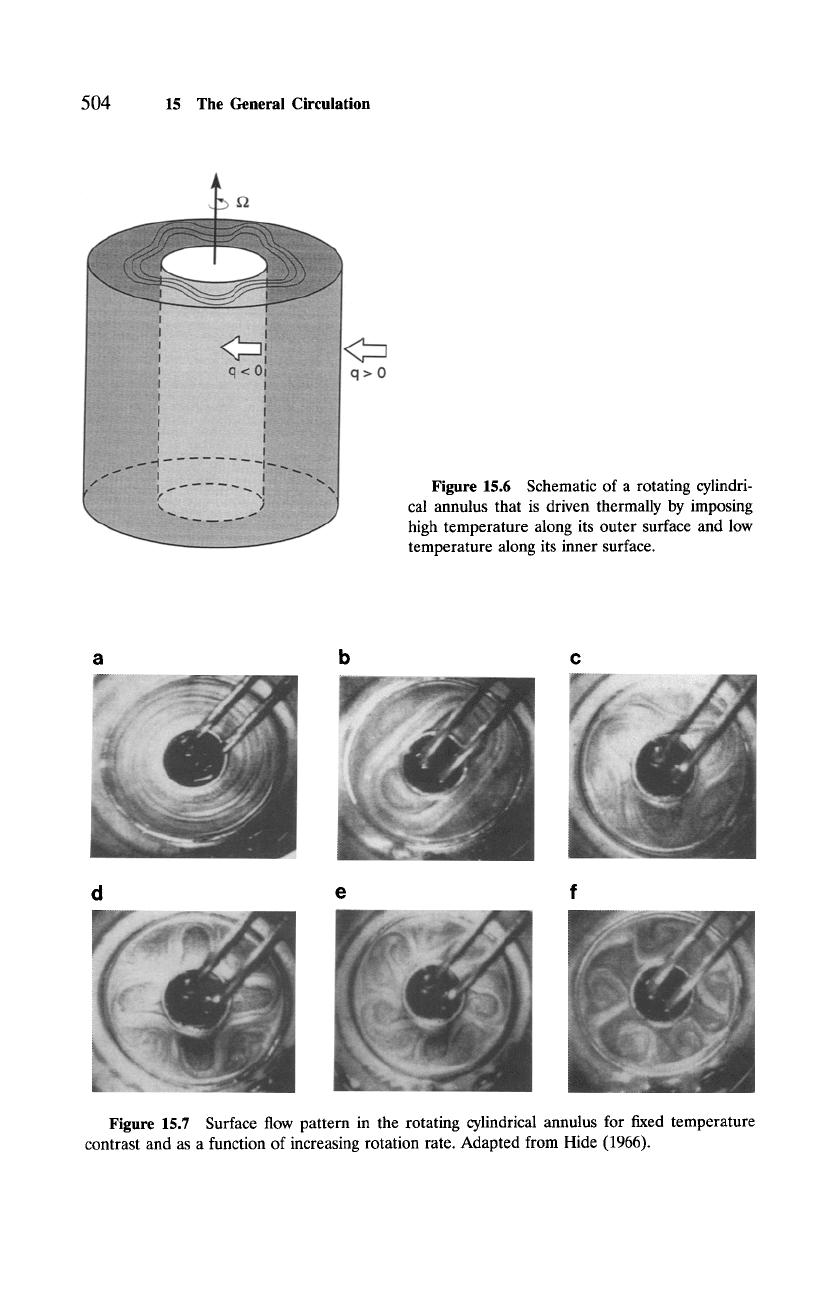
504 15 The General Circulation
<3=
q>O
Figure 15.6 Schematic of a rotating cylindri-
cal annulus that is driven thermally by imposing
high temperature along its outer surface and low
temperature along its inner surface.
a
~!iiiiii~ ....... ~iiiiiiiiiiiiiiiiiiiiiiiiiiiiiili ....
d e
c
i ~ ........
~"~"~i ~:!i!ili i i~i~'~' ......
ii ~':~ ..:,i ~' .....
Figure 15.7 Surface flow pattern in the rotating cylindrical annulus for fixed temperature
contrast and as a function of increasing rotation rate. Adapted from Hide (1966).
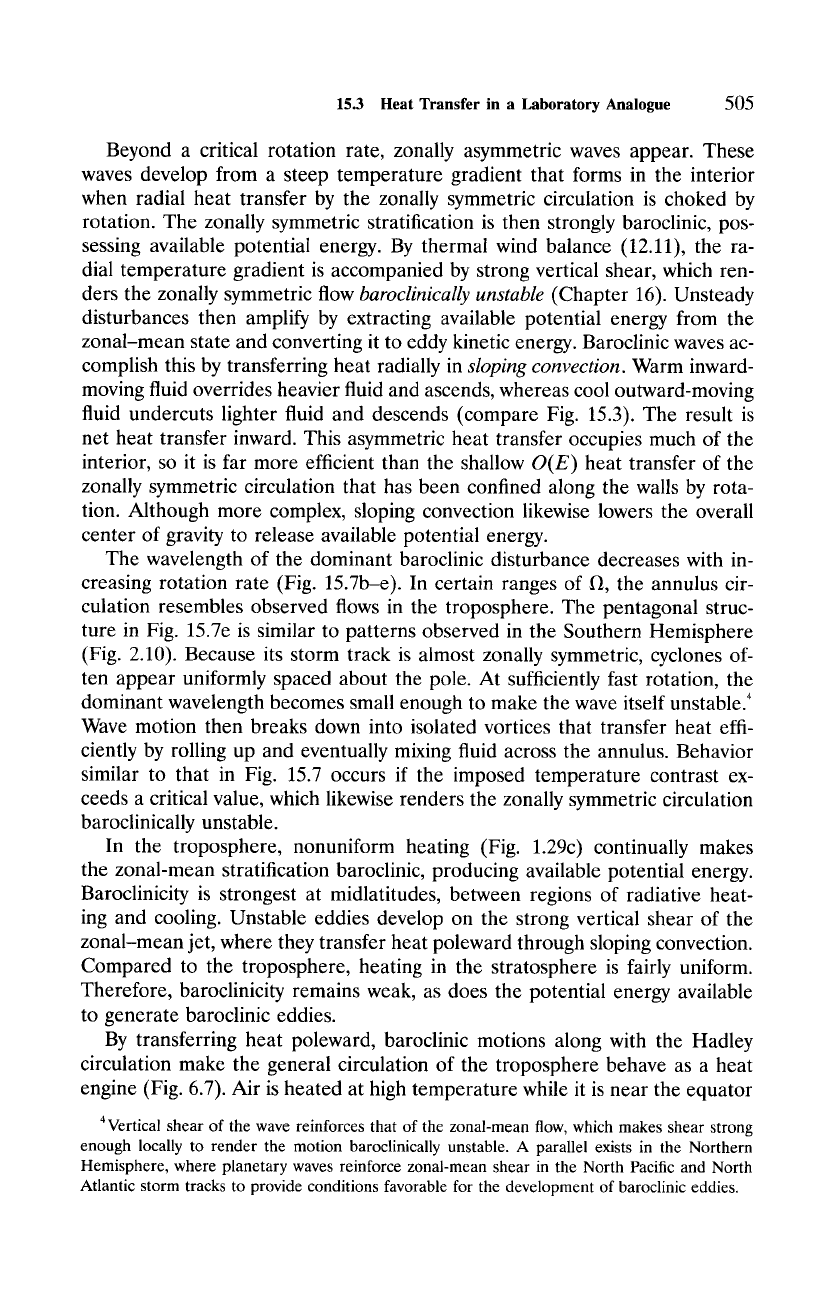
15.3
Heat Transfer in a Laboratory Analogue
505
Beyond a critical rotation rate, zonally asymmetric waves appear. These
waves develop from a steep temperature gradient that forms in the interior
when radial heat transfer by the zonally symmetric circulation is choked by
rotation. The zonally symmetric stratification is then strongly baroclinic, pos-
sessing available potential energy. By thermal wind balance (12.11), the ra-
dial temperature gradient is accompanied by strong vertical shear, which ren-
ders the zonally symmetric flow
baroclinically unstable
(Chapter 16). Unsteady
disturbances then amplify by extracting available potential energy from the
zonal-mean state and converting it to eddy kinetic energy. Baroclinic waves ac-
complish this by transferring heat radially in
sloping convection.
Warm inward-
moving fluid overrides heavier fluid and ascends, whereas cool outward-moving
fluid undercuts lighter fluid and descends (compare Fig. 15.3). The result is
net heat transfer inward. This asymmetric heat transfer occupies much of the
interior, so it is far more efficient than the shallow
O(E)
heat transfer of the
zonally symmetric circulation that has been confined along the walls by rota-
tion. Although more complex, sloping convection likewise lowers the overall
center of gravity to release available potential energy.
The wavelength of the dominant baroclinic disturbance decreases with in-
creasing rotation rate (Fig. 15.7b-e). In certain ranges of [l, the annulus cir-
culation resembles observed flows in the troposphere. The pentagonal struc-
ture in Fig. 15.7e is similar to patterns observed in the Southern Hemisphere
(Fig. 2.10). Because its storm track is almost zonally symmetric, cyclones of-
ten appear uniformly spaced about the pole. At sufficiently fast rotation, the
dominant wavelength becomes small enough to make the wave itself unstable. 4
Wave motion then breaks down into isolated vortices that transfer heat effi-
ciently by rolling up and eventually mixing fluid across the annulus. Behavior
similar to that in Fig. 15.7 occurs if the imposed temperature contrast ex-
ceeds a critical value, which likewise renders the zonally symmetric circulation
baroclinically unstable.
In the troposphere, nonuniform heating (Fig. 1.29c) continually makes
the zonal-mean stratification baroclinic, producing available potential energy.
Baroclinicity is strongest at midlatitudes, between regions of radiative heat-
ing and cooling. Unstable eddies develop on the strong vertical shear of the
zonal-mean jet, where they transfer heat poleward through sloping convection.
Compared to the troposphere, heating in the stratosphere is fairly uniform.
Therefore, baroclinicity remains weak, as does the potential energy available
to generate baroclinic eddies.
By transferring heat poleward, baroclinic motions along with the Hadley
circulation make the general circulation of the troposphere behave as a heat
engine (Fig. 6.7). Air is heated at high temperature while it is near the equator
4Vertical shear of the wave reinforces that of the zonal-mean flow, which makes shear strong
enough locally to render the motion baroclinically unstable. A parallel exists in the Northern
Hemisphere, where planetary waves reinforce zonal-mean shear in the North Pacific and North
Atlantic storm tracks to provide conditions favorable for the development of baroclinic eddies.
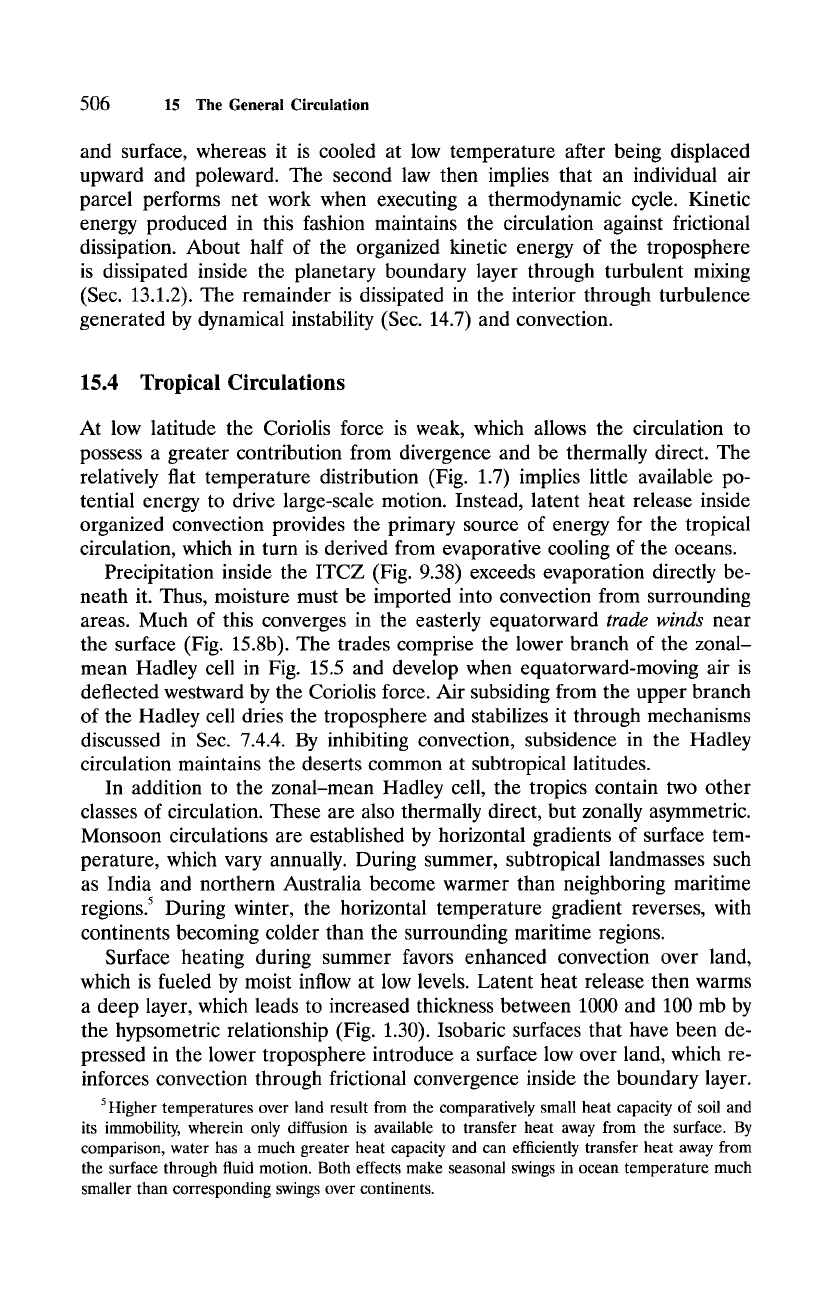
506
15 The General Circulation
and surface, whereas it is cooled at low temperature after being displaced
upward and poleward. The second law then implies that an individual air
parcel performs net work when executing a thermodynamic cycle. Kinetic
energy produced in this fashion maintains the circulation against frictional
dissipation. About half of the organized kinetic energy of the troposphere
is dissipated inside the planetary boundary layer through turbulent mixing
(Sec. 13.1.2). The remainder is dissipated in the interior through turbulence
generated by dynamical instability (Sec. 14.7) and convection.
15.4 Tropical Circulations
At low latitude the Coriolis force is weak, which allows the circulation to
possess a greater contribution from divergence and be thermally direct. The
relatively flat temperature distribution (Fig. 1.7) implies little available po-
tential energy to drive large-scale motion. Instead, latent heat release inside
organized convection provides the primary source of energy for the tropical
circulation, which in turn is derived from evaporative cooling of the oceans.
Precipitation inside the ITCZ (Fig. 9.38) exceeds evaporation directly be-
neath it. Thus, moisture must be imported into convection from surrounding
areas. Much of this converges in the easterly equatorward
trade winds
near
the surface (Fig. 15.8b). The trades comprise the lower branch of the zonal-
mean Hadley cell in Fig. 15.5 and develop when equatorward-moving air is
deflected westward by the Coriolis force. Air subsiding from the upper branch
of the Hadley cell dries the troposphere and stabilizes it through mechanisms
discussed in Sec. 7.4.4. By inhibiting convection, subsidence in the Hadley
circulation maintains the deserts common at subtropical latitudes.
In addition to the zonal-mean Hadley cell, the tropics contain two other
classes of circulation. These are also thermally direct, but zonally asymmetric.
Monsoon circulations are established by horizontal gradients of surface tem-
perature, which vary annually. During summer, subtropical landmasses such
as India and northern Australia become warmer than neighboring maritime
regions. 5 During winter, the horizontal temperature gradient reverses, with
continents becoming colder than the surrounding maritime regions.
Surface heating during summer favors enhanced convection over land,
which is fueled by moist inflow at low levels. Latent heat release then warms
a deep layer, which leads to increased thickness between 1000 and 100 mb by
the hypsometric relationship (Fig. 1.30). Isobaric surfaces that have been de-
pressed in the lower troposphere introduce a surface low over land, which re-
inforces convection through frictional convergence inside the boundary layer.
5 Higher temperatures over land result from the comparatively small heat capacity of soil and
its immobility, wherein only diffusion is available to transfer heat away from the surface. By
comparison, water has a much greater heat capacity and can efficiently transfer heat away from
the surface through fluid motion. Both effects make seasonal swings in ocean temperature much
smaller than corresponding swings over continents.
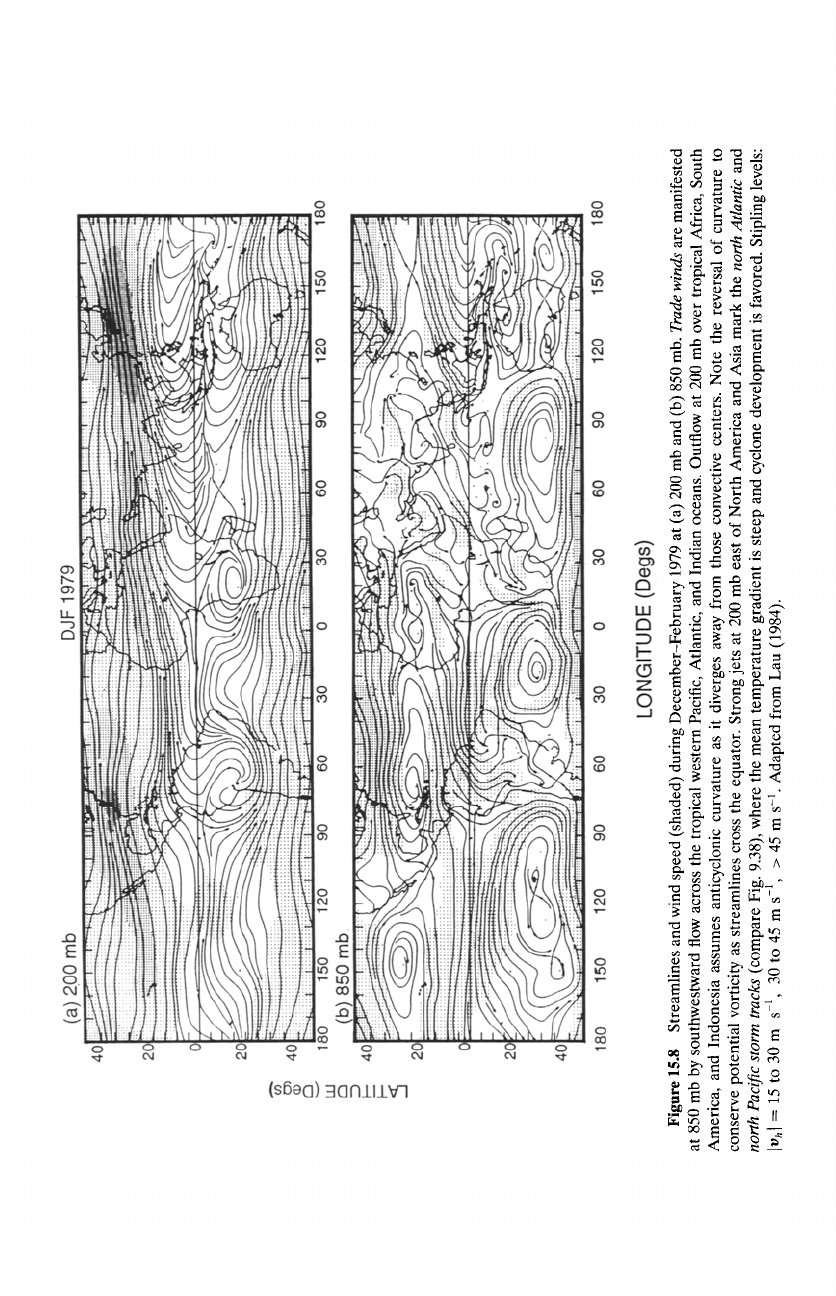
~o
0 ,--
(s6ec])
qC]NIIIV-I
~ ~=
,JD ~ ~D
~ o
~88Z~
*-~ (D
1=~ ,-~ ""
~.~
~ ~
.o
~
= .
"~ .~ ~ ,.
cr
~~ ~o
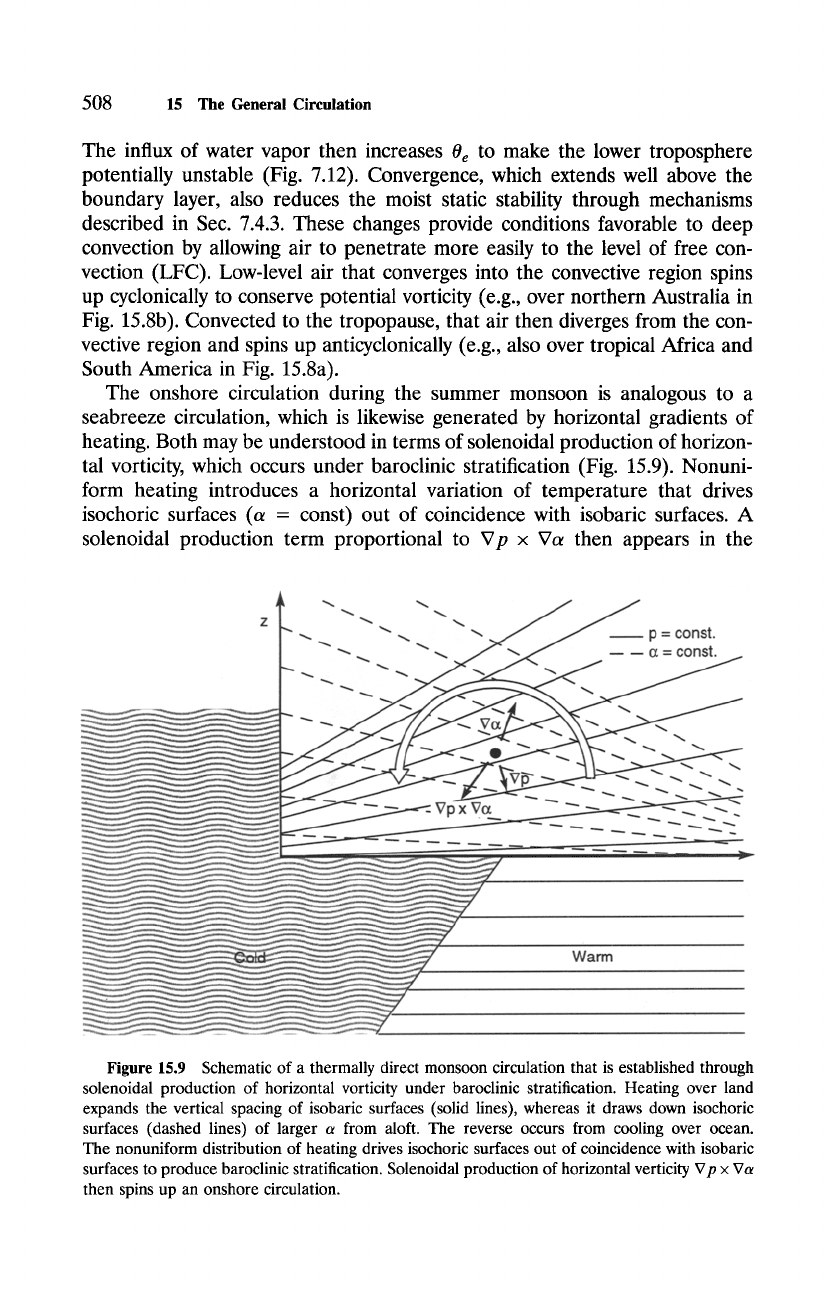
508 15 The General Circulation
The influx of water vapor then increases
0 e
to make the lower troposphere
potentially unstable (Fig. 7.12). Convergence, which extends well above the
boundary layer, also reduces the moist static stability through mechanisms
described in Sec. 7.4.3. These changes provide conditions favorable to deep
convection by allowing air to penetrate more easily to the level of free con-
vection (LFC). Low-level air that converges into the convective region spins
up cyclonically to conserve potential vorticity (e.g., over northern Australia in
Fig. 15.8b). Convected to the tropopause, that air then diverges from the con-
vective region and spins up anticyclonically (e.g., also over tropical Africa and
South America in Fig. 15.8a).
The onshore circulation during the summer monsoon is analogous to a
seabreeze circulation, which is likewise generated by horizontal gradients of
heating. Both may be understood in terms of solenoidal production of horizon-
tal vorticity, which occurs under baroclinic stratification (Fig. 15.9). Nonuni-
form heating introduces a horizontal variation of temperature that drives
isochoric surfaces (a = const) out of coincidence with isobaric surfaces. A
solenoidal production term proportional to
V p x Va
then appears in the
L ~
Z ~
p = const.
-- -- o~ = const.
- ~ ~
_
_. ....._ _..._.
~ ~ ~
~_....."
------ ......,.......... ....
Warm
Figure 15.9 Schematic of a thermally direct monsoon circulation that is established through
solenoidal production of horizontal vorticity under baroclinic stratification. Heating over land
expands the vertical spacing of isobaric surfaces (solid lines), whereas it draws down isochoric
surfaces (dashed lines) of larger a from aloft. The reverse occurs from cooling over ocean.
The nonuniform distribution of heating drives isochoric surfaces out of coincidence with isobaric
surfaces to produce baroclinic stratification. Solenoidal production of horizontal verticity Vp x Va
then spins up an onshore circulation.
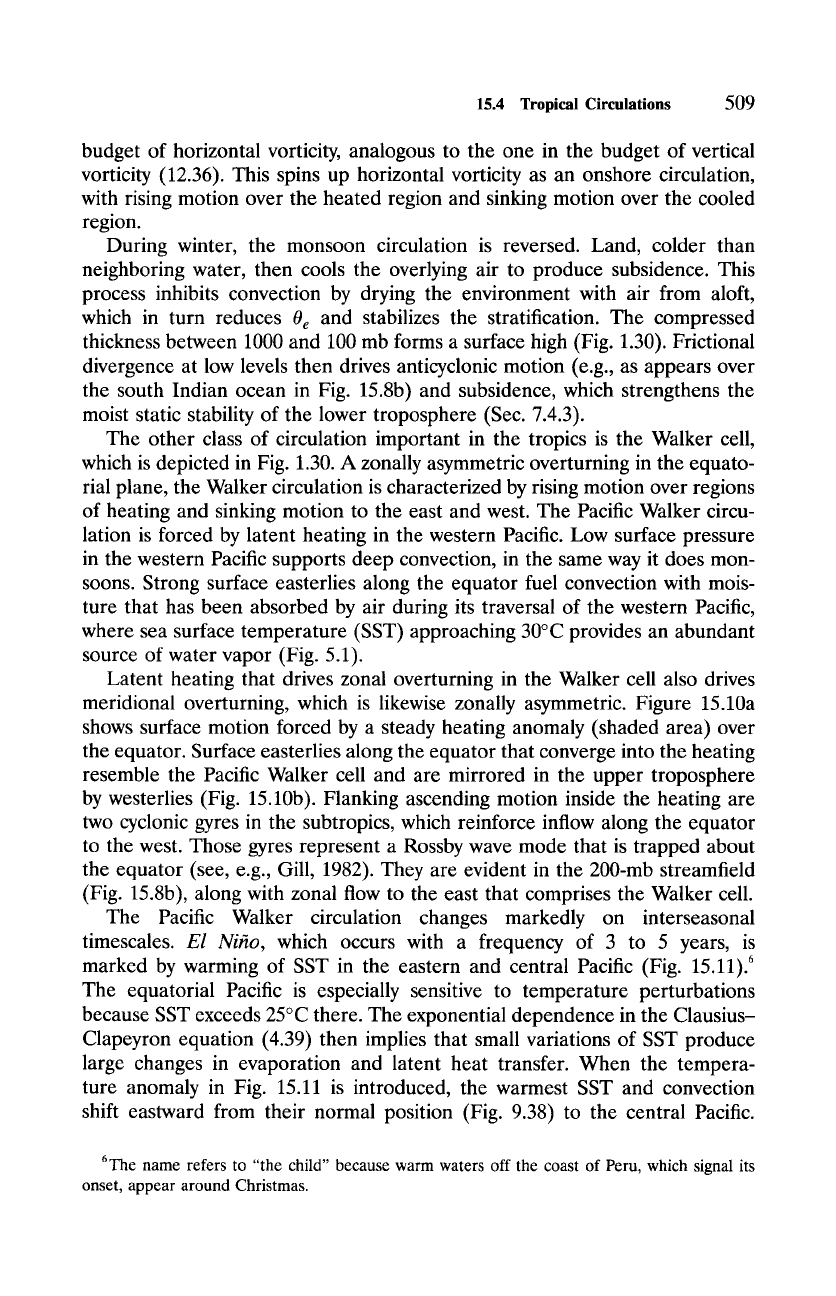
15.4 Tropical Circulations
509
budget of horizontal vorticity, analogous to the one in the budget of vertical
vorticity (12.36). This spins up horizontal vorticity as an onshore circulation,
with rising motion over the heated region and sinking motion over the cooled
region.
During winter, the monsoon circulation is reversed. Land, colder than
neighboring water, then cools the overlying air to produce subsidence. This
process inhibits convection by drying the environment with air from aloft,
which in turn reduces 0e and stabilizes the stratification. The compressed
thickness between 1000 and 100 mb forms a surface high (Fig. 1.30). Frictional
divergence at low levels then drives anticyclonic motion (e.g., as appears over
the south Indian ocean in Fig. 15.8b) and subsidence, which strengthens the
moist static stability of the lower troposphere (Sec. 7.4.3).
The other class of circulation important in the tropics is the Walker cell,
which is depicted in Fig. 1.30. A zonally asymmetric overturning in the equato-
rial plane, the Walker circulation is characterized by rising motion over regions
of heating and sinking motion to the east and west. The Pacific Walker circu-
lation is forced by latent heating in the western Pacific. Low surface pressure
in the western Pacific supports deep convection, in the same way it does mon-
soons. Strong surface easterlies along the equator fuel convection with mois-
ture that has been absorbed by air during its traversal of the western Pacific,
where sea surface temperature (SST) approaching 30~ provides an abundant
source of water vapor (Fig. 5.1).
Latent heating that drives zonal overturning in the Walker cell also drives
meridional overturning, which is likewise zonally asymmetric. Figure 15.10a
shows surface motion forced by a steady heating anomaly (shaded area) over
the equator. Surface easterlies along the equator that converge into the heating
resemble the Pacific Walker cell and are mirrored in the upper troposphere
by westerlies (Fig. 15.10b). Flanking ascending motion inside the heating are
two cyclonic gyres in the subtropics, which reinforce inflow along the equator
to the west. Those gyres represent a Rossby wave mode that is trapped about
the equator (see, e.g., Gill, 1982). They are evident in the 200-mb streamfield
(Fig. 15.8b), along with zonal flow to the east that comprises the Walker cell.
The Pacific Walker circulation changes markedly on interseasonal
timescales.
El Niho,
which occurs with a frequency of 3 to 5 years, is
marked by warming of SST in the eastern and central Pacific (Fig. 15.11). 6
The equatorial Pacific is especially sensitive to temperature perturbations
because SST exceeds 25~ there. The exponential dependence in the Clausius-
Clapeyron equation (4.39) then implies that small variations of SST produce
large changes in evaporation and latent heat transfer. When the tempera-
ture anomaly in Fig. 15.11 is introduced, the warmest SST and convection
shift eastward from their normal position (Fig. 9.38) to the central Pacific.
6The name refers to "the child" because warm waters off the coast of Peru, which signal its
onset, appear around Christmas.
